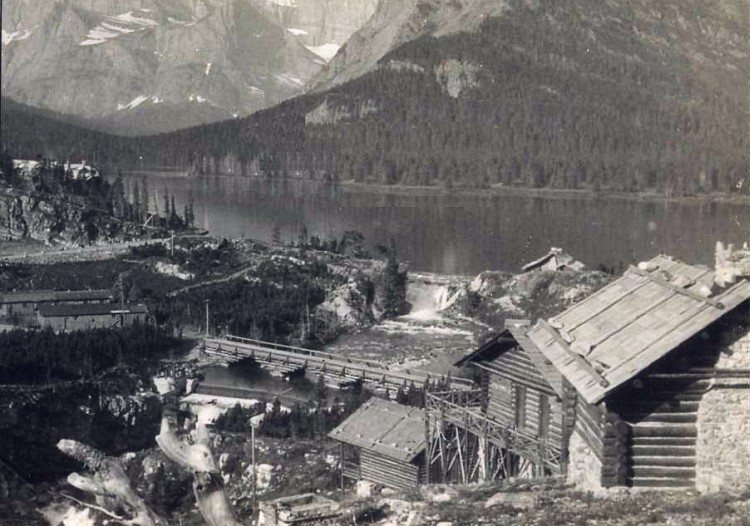Fits, Starts, Failure, Fire
Although the chalets at Swiftcurrent Lake existed for a quarter of a century, their use as guest lodging was extremely brief. The site was selected and construction began on a field and hillside near what was narrow Lake McDermott. Like most of the other chalet colonies, it was designed to be a stop for roughing it in luxury on pack tours through America's next National Park. Unfortunately for the chalets, the neighborhood soon got extremely crowded.
Great Northern Railway president Louis Hill set about looking for a dramatic setting for his "grand alpine hotel," the ultimate vacation destination for tourists who would not be partaking of the rugged pack trips. When the newly built road brought Hill to check on the progress at Lake McDermott Chalets, he decided that the valley floor was ideal for a lakeside alpine hotel.
The only fly in the ointment was that the lake shore was unsuitable for construction, and the lake wasn't all that useful for boat tours. Hill, with the blessing of Stephen Mather, supposedly tinkered with Swiftcurrent Falls to raise the water to the level of a suitable construction site. Coincidentally, the agency that would become the park service decreed that the chalets' dining hall was in the wrong location, and would have to be moved. This would be a setback for the chalets, and not the last.
The dining hall relocation cost the Railway $30,000., equivalent to about $700,000. in today's dollars. Moving such a structure today would require a phalanx of engineers, attorneys, forms and fees and multiple levels of bureaucracy, and would easily cost millions. Even with the lack of soft costs, the expense was a hefty sum at the time and meant that the chalet complex at Lake McDermott would operate in the red for a few years.
We can only speculate why Hill agreed to meet such a demand from an agency that was only loosely defined at the time. It stands to reason that the relocated dining hall was a trade-off for the alleged permission to raise Lake McDermott.
After the grand Many Glacier Hotel was built, management assumed that it would be business as usual at the Chalets. It had to be, if nothing else than to recoup the cost of moving the dining hall. Unfortunately the hills had other plans for Hill's Chalets; an avalanche destroyed the new dining hall -- as well as a couple of lodgings -- less than a year after it was moved.
With expansion planned for the hugely successful hotel, funds were simply unavailable for yet another dining facility. It was determined that for the 1913 season, guests would walk to the new hotel to take their meals. This was altogether unpopular during inclement weather. The hotel soon expanded, and the need for lodging at the chalets diminished.
By 1917 the chalets were used almost exclusively for employee housing, including maintenance and hotel workers, as well as any "packers" that remained. Many of the residents were students doing seasonal work in the hotel. Each summer the population swelled, and the chalet colony became a close-knit mountain community. The youthful employees enjoyed this immensely, although it was balanced out by long arduous hours in the hotel.
The chalets served this purpose quite well until the massive forest fire of 1936. The young men were ordered to the fire fighting stations at the grand hotel, adandoning the chalets to the fates. They fought the fire boldly; legend has it that the young men enjoyed aiming firehoses at each other when the inferno subsided. The proximity to the lake helped the efforts at the Many Glacier Hotel, and enabled two of the Many Glacier Chalet structures to be saved. The rest of the complex burned to the foundations.
Two buildings survive today; they are used for maintenance and as an employee bunkhouse. These buildings are along the lakeshore near the Swiftcurrent dam.
